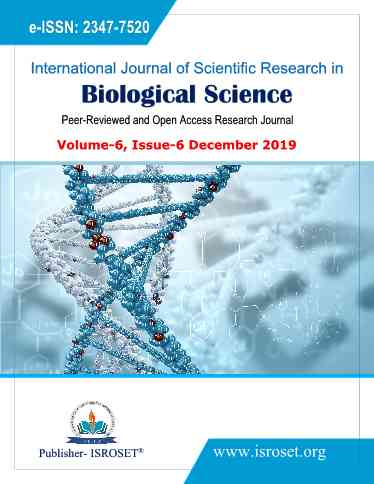Cytotoxic Activity of Phenolic Compound Isolated From Pandanus Odorattissimus against (MDA-MB-231) Breast Cancer Cell Lines
Keywords:
Cytotoxic activity, Comet assay, Pandanus odorattissimus LAbstract
The present study reports potential activities like cytotoxic, genotoxic and apoptotic activity of phenolic compound 4-(4-(3,4-dimethoxyphenyl)hexahydrofuro[3,4-c]furan-1-yl)-2-methoxyphenyl acetate isolated from methanolic extract of Pandanus odorattissimus. The compound showed a significant cytotoxic effect on MDA-MB-231 cell line. Exposure of the compound reduced the viability of MDA-MB-231 cells after 24, 48 and 72 hours, the compound exerted a significant cytotoxic effect on MDA-MB-231 cells. The compound also induced significant DNA damage. The results of comet assay with pattern of the MDA-MB-231 cells has shown an intact head and complete absence of DNA fragments in the form of tail suggesting that the doses are not genototoxic. The phenolic compound at concentration of 20 µg/mL, showed an increase in percentage tail of DNA upto 5.87 units when compared to control 5.05.
References
Shahedur R, Faizus S, Asif I, BMC Complementary and Alternative Medicine, 11, 76, 2011.
Weimin Z, Lili Z, Jürgen R, Pharm Biol, 9, 886, 2009.
Dongwu L, Zhiwei C, J Breast Cancer, 2, 133, 2013.
Schwartsmann G, Ratain MJ, Cragg GM, Wong JE, Saijo N, Parkinson DR et al. Anticancer drug discovery and development throughout the world. Journal of Clinical Oncology;20:47S–59S, 2002.
Newman DJ, Cragg GM, Snader KM.Natural products as sources of new drugs over the period. J. Nat. Prod;66:1022-37, Jul 2003.
6. Srivastava SK, Rai V, Srivastava M, Ra AK, wat S, Mehrotra S. Estimation of heavy metals in different Berberis Species and its market samples. Environ Monit Assess.;116:315-20, May 2006.
Gupta SC, Kim JHS, Prasad BB. Regulation of survival, proliferation, invasion, angiogenesis, and metastasis of tumor cells through modulation of inflammatory pathways by nutraceuticals, Cancer Metastasis Rev;29: 405, Sep 2010.
Sun Y, Xun K, Wang Y, Chen X. A systematic review of the anticancer properties of berberine, a natural product from Chinese herbs. Anticancer Drugs;20:757-69, 2009.
Keerthikar and Basu.. Indian Medicinal Plant, Sri Satguru Publication. Vol. 10 p.3565, 2000.
J.paul, Cell and Tissue Culture : pp 177- 184, chruchill livingstone, Edinburgh. 1975.
Mosmann, T. Rapid Colorimetric Assay for Cellular Growth and Survival: Application to Proliferation and Cytotoxicity Assays. Journal of Immunological Methods, 65, 55-63, 1983.
Y.O. Son, J. Kim, J.C. Lim, Y. Chung, G.H. Chung, J.C. lee Ripe fruits of Solanum nigrum L. inhibit cell growth and induce apoptosis in MCF-7 cells Food Chem. Toxicol., 41 , pp. 1421-1428, 2003.
Collins A. R., Oscoz A. A., Brunborg G., Gaivão I., Giovannelli L., Kruszewski M., et al. .. The comet assay: topical issues. Mutagenesis 23, 143–151, 2008.
Singh N. P., McCoy M. T., Tice R. R., Schneider E. L.. A simple technique for quantitation of low levels of DNA damage in individual cells. Exp. Cell Res. 175, 184–191, 1988.
Hartmann A., Plappert U., Raddatz K., Grünert-Fuchs M., Speit G.. Does physical activity induce DNA damage? Mutagenesis 9, 269–272, 1994.
Grusch M, Fritzer-Szekeres M, Fuhrmann G, Rosenberger G, Luxbacher C, Elford HL, Smid K, Peters GJ, Szekeres T and Krupitza G (2001) Activation of caspases and induction of apoptosis by amidox and didox. Exp. Hematol. In press Stone MJ, Klintmalm GB, Polter D, et al: Neoadjuvant chemotherapy and liver transplantation for hepatocellular carcinoma: A pilot study in 20 patients. Gastroenterology;104:196–202, 1993.
Fenaux P, Chomienne C, Degos L. Treatment of acute promyelocytic leukaemia. Best Pract Res Clin Haematol;14(1):153-74, 2001.
Mayorga P, Perez KR, Cruz SM, Caceres A.. Comparison of bioassays using the anostracan crustaceans Artemia salina and Thamnocephalus platyurus for plant extract toxicity screening. Rev Bras Farmacogn. 20(6):897–903, 2010.
T. T. Jong and S. W. Chau, “Antioxidative Activities of Constituents Isolated from Pandanus Odoratissimus,” Phytochemistry, Vol. 49, No. 7, pp. 2145-2148, 1998.
Downloads
Published
How to Cite
Issue
Section
License

This work is licensed under a Creative Commons Attribution 4.0 International License.
Authors contributing to this journal agree to publish their articles under the Creative Commons Attribution 4.0 International License, allowing third parties to share their work (copy, distribute, transmit) and to adapt it, under the condition that the authors are given credit and that in the event of reuse or distribution, the terms of this license are made clear.







